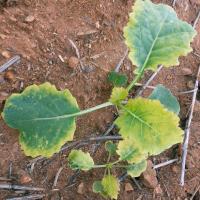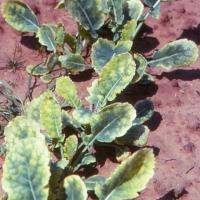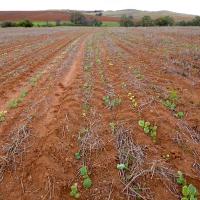Diagnosing manganese toxicity in canola
Manganese toxicity is rare in WA, but may occur on acidic heavy soils with high manganese levels.
What to look for
- Smaller, yellow plants that are more common on very acidic and heavy textured soils with high manganese content.
- Acidic red-brown loamy gravel. loam or clay derived from sediments or mafic rock could have high available manganese.
- Deficiency is most likely to occur in young canola in warm, drying soil after soaking rains.
Paddock
- Smaller yellowish plants.
- Yellowing of leaf margins that progresses inwards generally between leaf veins with some mottles.
- Leaves on more severely affected plants cup inwards and die from the margins.
- Plants recover in winter as the soil cools down and the growing plant accesses moisture with a lower manganeses content.
Plant
Where did it come from?
- With the exception of sands most soils contain manganese, but high levels are more common in fine textured, soils and loamy gravels.
- Soil manganese exists as an oxidised insoluble form and reduced to a water soluble form (Mn++). Activity of oxidising and reducing bacteria that control the ratio between these forms, varies with soil moisture, temperature,texture, and pH.
- With high soil temperature and (even short term) waterlogging, reducing bacteria produce Mn++.
- When waterlogging abates, oxidising bacteria convert Mn++ to insoluble forms , but this ceases when the soil dries and the bacteria can't access Mn++ containing water in fine soil pores.
- Acidic soil has higher levels of Mn++.
- Manganese toxicity is most likely to occur in canola sown into warm acidic heavy soil after soaking rain, folllowed by dry conditions.
- Toxicity will abate as the soil temperature declines in winter.
Management strategies
- Plants usually continue to grow despite toxicity symptoms. There is no in-crop treatment.
- Liming is the most economical method to ameliorate manganese toxicity.
- Heavy soils need higher rates per unit of soil to produce the same pH increase as sandy soils.
How can it be monitored?

Tissue test
- Whole-top plant test provides a guide if paired good/ poor samples are taken.
- Whole shoots of young plants levels above 400-700 mg/kg indicate toxicity.
- Manganese soil tests can only indicate potential for toxicity, as Mn++ levels can vary rapidly according to soil conditions.
- 0-10cm soil pH below 4.5, also increases the risk, and indicates that the soil requires liming to reduce losses from reduced phosphorus availability and possible aluminium toxicity.
Where to go for expert help
Page last updated: Thursday, 5 February 2015 - 3:22pm




